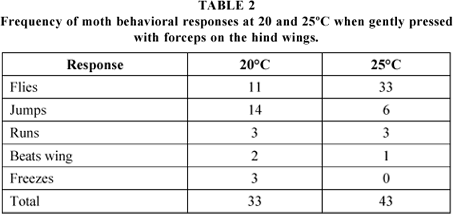Ectotherm locomotion is restricted by low temperatures, and many species, such as some flying insects, need to achieve thermal thresholds before taking off. Body size influences heat exchange between an animal and the environment. Therefore, larger animals have higher thermal inertia, and necessarily spend more time in pre-flight warming up, a critical period when they remain exposed and more susceptible to predators. Thus, one could expect larger animals, along their evolutionary history, to have developed a more diversified repertoire of defensive behaviors when compared to their smaller counterparts. Moths are an interesting model for testing this hypothesis, as they exhibit considerable variation in body size and many species present pre-flight warming up by muscle shivering, an evidence of thermal restriction on locomotion. I registered the responses of 76 moths immediately after simulating the attack of a predator and then associated behavioral response to body size. I conducted the experiments at 20 and 25ºC to check for possible thermal restrictions on behavior, and identified animals to the family level to check for the effects of a common phylogenetic history. When disturbed at 25ºC, smaller moths tend to fly, while larger ones tend to run. At 20ºC almost all moths ran, including the smaller ones, indicating a possible thermal restriction on flight. Corroborating the proposed hypothesis, a more diversified repertoire of defensive behaviors was registered among larger moths. An alternative interpretation would be that common behaviors among related moths could be explained by common phylogenetic histories. However, two facts support the physiological restriction hypothesis: (1) the analysis within Sphingidae and Geometridae (not closely related families) showed similar results to those of the overall analysis, and (2) a more diverse repertoire of defensive behaviors was associated to the lower, and therefore more restrictive to locomotion, temperature (20ºC).
body size; thermoregulation; defensive behavior; temperature; moths




